Not everywhere we go has a story, but each has its moment. Here’s a kaleidoscope of moments in our life on the highways and byways of Australia.

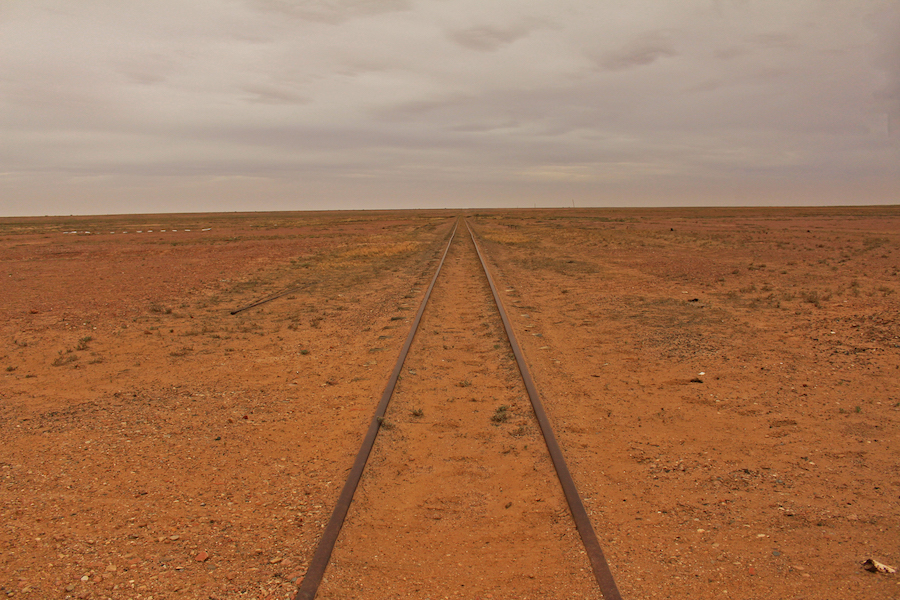
Modern technology has given us electric cars and rockets to Mars, but you still can’t beat driving a classic old outback track across Australia, in a quarter century old 4WD!
The outback tracks in Australia were predominantly stock routes – some were more “official” than others
Having finally made it across from the east coast on The Big Detour, out first Aussie outback track was, strangely named after a Polish explorer. But what an explorer! Pawel Strzelecki was about as different from Australia’s famously failed adventurers Burke and Wills as you could get.
Born of noble stock in Poland he became a notable explorer, navigating his way around North and South America, Europe, Africa, Cuba and many south Pacific islands before arriving in Australia in 1839.
While in Australia he explored and surveyed vast areas of Gippsland and the Snowy Mountains – climbing and naming Australia’s highest Mount Kosciuszko in honour of a national hero in Poland. He mapped Tasmania, mainly travelling on foot and in all covered 11,000 kilometers of New South Wales, Victoria and Tasmania. He eventually left for England via China, the East Indies and Egypt and on arrival was recognized by the Royal Geographical Society.
Strzelecki did much good work in his life, including coordinating famine relief in Ireland and was given many awards. It is not only the Track that bears his name in Australia, but also a desert, a mountain range, a mountain, a peak, a creek and a highway.
It is ironic that the Track which is named after such an upstanding man was actually mapped out by a thieving bushranger.
Harry Redford was working a cattle station in Queensland which was so large that he realized the owners wouldn’t even notice if some of their cattle went “missing”. Over a three month period in 1870 he corralled and then drove 1,000 cattle through some of the harshest outback lands, including carving a track through the Strzelecki Desert. His 1,000kilometer journey was so impressive and audacious that when he was finally caught, the jury acquitted him.
Thankfully we didn’t have any cattle to herd and these days on a good day the Strzelecki Track could be driven at 100kmph in a Toyota Camry.
Even the road trains steam through – leaving their mark on everything they pass!
But on a bad day it can’t be driven at all. We had a good day to start with, but spotted a few signs of what it can be like on a bad one.
And then we found out how little it takes for it to be a bad one.
Just a spit of rain turned the baked earth into sloppy, cloying mud. Much more rain and we would not have made it through.
But like Strzelecki and Redford, we finally got to the other end, sliding into Marree, mud-coated and ready for our next classic track.
Marree is the start of the Oodnadatta Track – an historic outback town that is proud of its history.
The Oodnadatta Track from Marree to Marla is another Australian touring legend. Named after a small town along its stretch, the track is a dirt road running more than 600km to the centre of Australia. It follows ancient Aboriginal ochre trading routes and it is easy to see why.
Much of the track runs parallel to Lake Eyre, which you can read and see more of in our previous blog “ Lake Eyre from the Air”.
As well as the wonders of the Lake, the semi desert track holds many surprises.
Plane Henge is a sculpture park 70 kilometers into the desert with planes, parts of trains and automobiles fashioned into glorious quirkiness.
Man-made curiosities were almost outdone by the natural ones. Far below the sand and red earth is the Great Artesian Basin – a massive underground natural water supply and system. Every now and then along the Oodnadatta Track the underground comes overground.
The Wabma Kadarbu Mound Springs are an oasis of softly bubbling calm literally in the middle of nowhere.
They are part of a string of springs through the region that were used by Aborigines for generations. More recently the easy access to water was the rationale for running the iconic Ghan railway line and overland telegraph through the region.
The old Ghan line is long gone, but its ghost remains all along the track.
Sometimes the good times roll again. One of siding shed is now famous for its annual outback new year’s even ball, but for most of the year the sands are slowly taking back the land.
One man-made structure that is still maintained through the desert is the Dog Fence. The Dog Fence is the longest fence in the world. This humble stretch of wood and wire first built in the 1880’s is one of the longest structures in the world. Designed to keep dingoes away from sheep stock, it runs a mind-boggling 5,614km from the east to the south of Australia. And that is a couple of thousand kilometers shorter than it used to be!
Hundreds of men live along the fence, working in shifts and sleeping in small huts complete with satellite TV and shortwave radios to keep the barrier intact.
Our Oodnadatta journey ended just over half way up the track. We spent five days at William Creek, flying over Lake Eyre and helping out at the local pub. From there we turned off the Track and took the shorter Coober Pedy Track to the opal-mining town of of the same name. The Living Fire is the fascinating story of that strange mining town. We fully intend to return and finish the last stretch one day.
We’ve seen emus, roos and critters galore.
We have watched eagles soar on the endless thermals across a huge sky. We have battled lashing rain, all-enveloping, choking dust storms, energy-sapping heat and many, many flies.
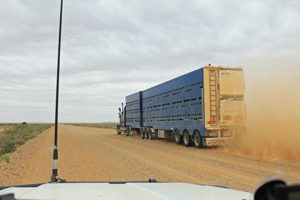
About the only thing we saw on the whole journey and once he passed we couldn’t see very much at all
We rarely saw another human soul until we get close to a town and even then they are few and far between. But it is those hardy men and women from generations past, and the tough old buggers that still call the outback home who have made our recent journeys across the old stock tracks possible and so memorable.
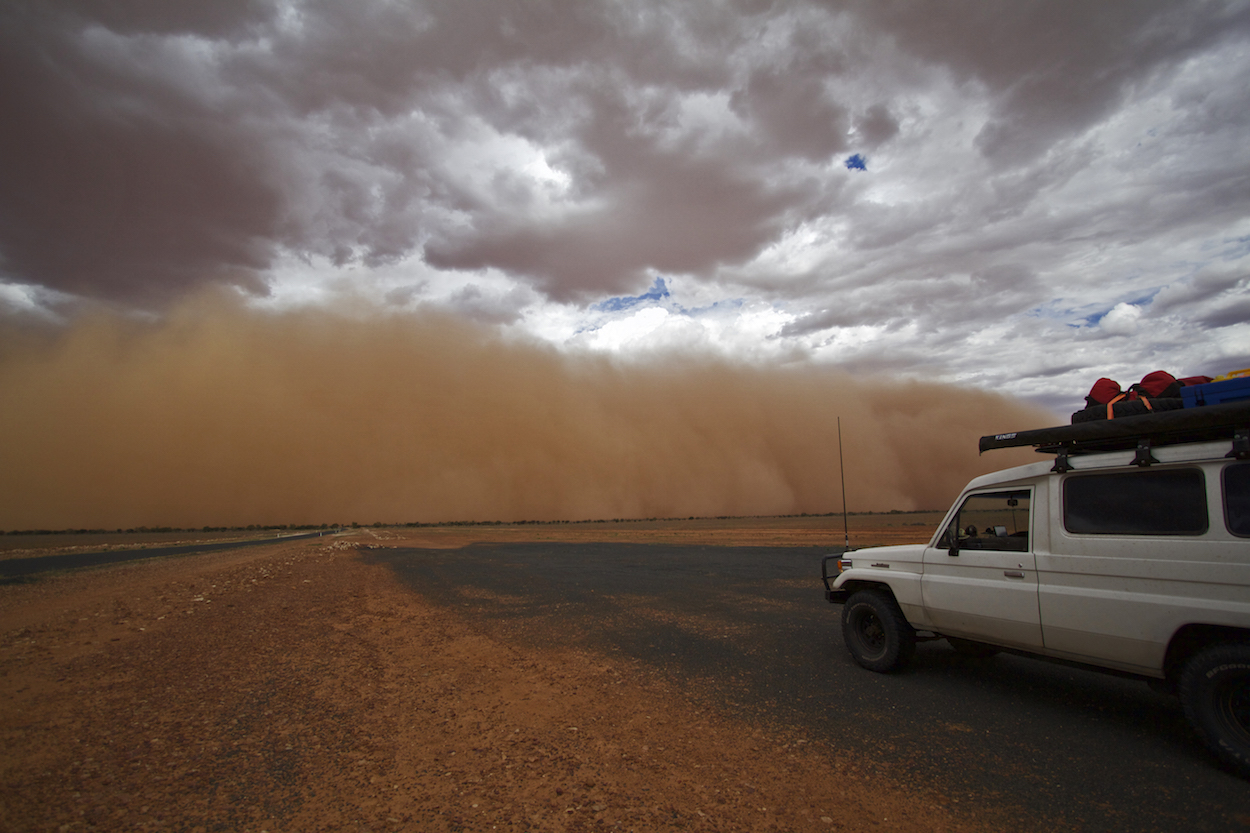
We were on our way to Lake Eyre. We weren’t even planning to go there, but just a six word message started a 3,000km detour. The joy of unplanned vagabonding!
Our journey began right on the edge – as far from the red centre as we could get – on the most easterly point Australia at Byron Bay lighthouse.
We were heading north to Cape York. But one text message from Geoff’s brother, Chris, to say “there is water in Lake Eyre” – an extremely rare occurrence – and we turned left and west – direction, the aptly named Adventure Way and a 2,500km detour from the original plan.
One of our first stops was an unassuming high street with a big claim to fame:
Tenterfield is credited as being the place where the Australian nation was born, following a fiery speech by Henry Parkes, a local politician strongly advocating unity of the colonies.
Such was the persuasiveness of his argument that is sparked the movement which produced the federation just over a decade later.
After Tenterfield there was not so much fire, but water. And it wasn’t long before we were an integral part of nature’s story.
Torrential rain at Goondiwindi meant camping was cancelled in favour of a nice dry room at the splendid Victoria Hotel and although we left in bright sunshine the boggy roadsides told a different story.
And many people thought we were crazy to do the trip in high summer. The signs were everywhere
But so was the welcome.
Nindigully Pub is a classic outback institution, miles from anywhere and also closed when we got there. But they opened up and offered a welcome cold beer when we pulled up.
They also had all the gossip despite their remote location – something we found repeated at every stop!
At Bollon the one-street town provides a beautiful free campsite alongside the river.
When we arrived the locals had pulled up their chairs to watch the waters as they lapped at the sides of the road. We met Lonnie, the local policeman, general store-owner, gas station manager, camp oven cooking expert and world champion sheep shearer.
Next stop Cunnamulla, where we were told that the road ahead at Eulo was flooded and we couldn’t get through.
Eulo normally prides itself on the fact that the 50 residents share the town with 1500 lizards, but on that day it had a different claim to fame.
It wasn’t just a flooded road, but also a washed out bridge that stopped us and everyone else in their tracks.
We turned around and headed back to Cunnamulla only to discover the roadside show at Bollon had just got better and that road was now washed out too! Our only option for a bridge over the river was 300km north, and so began a 600km detour from our detour. We were starting to appreciate the trials of outback travel.
We were also beginning to really appreciate the generosity of outback communities. At Wyandra the town laid on a gorgeous free campsite, complete with fire pit, solar showers, a camp kitchen and a mob of kangaroos for company.
From Wyandra we continued our northern loop around the floods, through Charleville, where appropriately, the summer heat started to crank up again. An average day was topping 40 degrees. Charleville was most memorable to us for the marvelous Clement Wragge, the self-styled “rain-maker” who tried in vain to bring water during one of the worst droughts in the region.
His fantastic Stiger Vortex rain canons designed to fire gases into the atmosphere that create clouds and therefore rain. The guns failed and the drought continued for many more months. We could have done with a few canon firings that day, as the mercury continued to rise. We stopped counting at 48.5degrees during the day and a balmy 37 degrees overnight, in a nylon tent!
Next stop Eromanga – a town whose name has made it famous in Japan for meaning cartoon porn or erotic manga.
It’s dusty, deserted streets didn’t feel erotic, but there was something cartoonish about the Canadian campsite manager who was deeply suspicious of our intentions, claiming no one had passed through the area in a month.
Onward we pressed heading toward Innamincka. It was not far from this isolated hamlet that two of Australia’s greatest failed adventurers, Burke and Wills met what some would say was their inevitable end. It is a story worthy reading and remarkable in it relentless hopeless endeavour. You can find our short version of it in The Long March to Failure.
Full of stories of disaster we modern-day adventurers were painfully aware of the darken skies above us and set out for Innamincka – which boasts a pub, an hotel and that’s about it. It was also our starting point for the Strzelecki Track.
Burke and Wills may have planned badly, but even they couldn’t be blamed for the brutal nature of Australian outback in the summer. We soon came to appreciate some of their pain.
What started out as a hot, clear blue day soon became iron-dark and brooding.
Before long the last bit of tarred road had given way to dirt and we were facing dueling storms – with half the sky blackened with thunder-clattering clouds and lightening bolts and the other a red-earth mass lifted off the ground more than a kilometer high and tens of kilometers wide.
Alone on the road we could see nothing all around, but had no choice but to keep going. Bad as the dust storm was, getting stuck on a dirt road a long way from nowhere in a thunderstorm was worse. The mud-sucking qualities of an outback track are as legendary as the tracks themselves.
The pictures tell the story better than we can
We finally punched through the dust storm and landed in Innamincka. Geoff poured kilos of dirt out of the air filter and the landlord poured cold beer.
All of that and we still hadn’t even got to the Tracks. But next stop and next story – we will take you down two of the classic Australian outback tracks roadtrips.
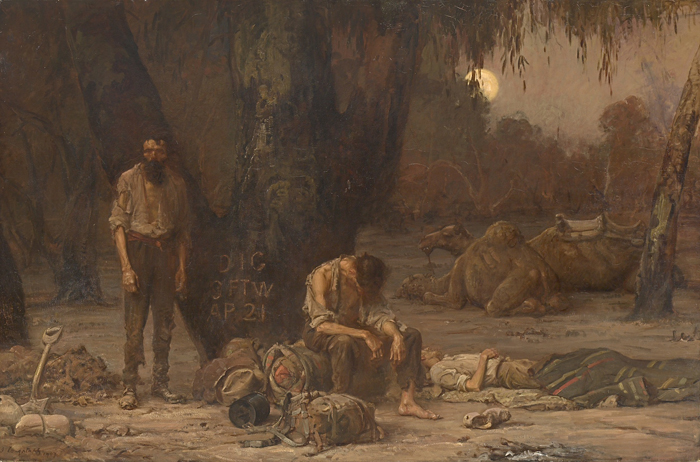
Robert Burke and John Wills’ ambitious expedition to map Australia from the south to north coasts in 1840 is a classic saga of bad planning, worse leadership and fatal consequences. Yet the two men are still memorialized in Australian history.
Finding a way through Australia’s harsh terrain from Melbourne on the south coast of the continent, to the Gulf of Carpentaria in the north – more than 3,000km – was a much prized goal.
Every colony, which have since become states, was considering the attempt and putting up considerable money for the victorious team.
So today it would seem strange that the financial backers of the Victoria expedition committee still chose the entirely inexperienced Robert Burke to head it. But factions within and dislike of “foreigners” on the committee, despite their expedition experience, meant local policeman Burke got the gig. It was a decision that proved fatal.
The signs were there from early on. Burke’s team of 19 men left the Royal Park in Melbourne in August 1860 with six wagons of supplies to last two years.
The committee had also decided in their wisdom that dried meat carried in three extra wagons, was a better idea than the normal practice of herding live cattle, which can move on their own and be slaughtered en route. Apparently an oak writing desk was also amongst the necessities loaded onto the creaking vehicles. One broke down before it even left the park; a second was lost within a few kilometers.
It took the team two months to travel 750km to the edge of what was still the colony of Victoria. The postal service usually took a week to travel the same route. By that time two of the expeditions five officers had resigned because of Burke’s leadership, making John Wills second in command; 13 men had been fired and 8 newly hired. It wasn’t looking good!
Because of fears that other explorers may beat them to the coast and claim the prize money, Burke decided to make a dash to the Gulf with Wills and team member John King, despite the journey being through the worst of the Australian summer in the outback. The rest of the group was left behind at a depot camp near Innamincka.
More bad decisions, illness, failing supplies and impassable swamps meant Burke’s team never made it to the coast and only three of the four made it back to the original camp, only to find the remaining team had left hours earlier. They had waited an extra month for the men to return, but finally given up hope, leaving supplies and instructions to “Dig” for them.
The Dig Tree is the last story in their catalogue of failings.
After using all the supplies, Burke and Wills made the final fatal judgement – deciding to make a 250km desert trek west to a stock station instead of retracing the steps of the depot party heading south. They left no message at the tree, so when the depot party returned with fresh supplies they did not know that the two men were only 35km away in the wrong direction.
Burke, Wills died within a few days and a few kilometers of rescue, ten months after they set out from Melbourne. In all seven men perished in pursuit of the prize. Perhaps the final insult of their failed endeavour is that the rescue party sent out to find the two men from competing colony of Queensland, because there was no sign they had been at the Dig Tree, kept on going north on their search and went on to successfully make the north-south trek and claim the prize money.
But because history and people are strange, it is still Burke and Wills who are remembered, despite their failure, and not that other guy who actually completed the mission.
Thousands lined the route for their funeral procession.
Their names are in every Australian history book. Statues, memorials, roads and monuments carry their story
their faces even ended up on the nation’s stamps.
So perhaps in some perverse way, they succeeded after all.
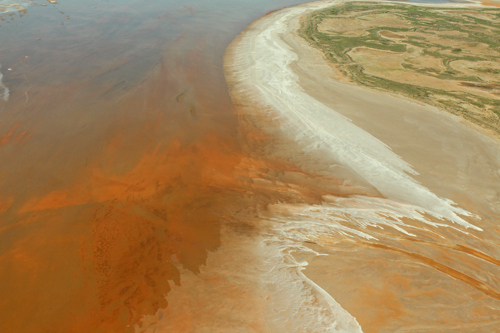
Lake Eyre is a massive contradiction. A lake where land speed records are broken. A salt flat with a sailing club. And it is a real sight to see.
It sits in the middle of a desert and is Australia’s lowest point at 15m below sea level. More than 140km long and 77km wide, most of the time it is a glittering, eye-scorching, shimmering white salt flat. It has filled only three times in the last 150 years.
But when it fills, Kati Thanda- Lake Eyre – to give it it’s full title – is the largest lake in Australia and becomes home to a mass of bird and marine life.
The Lake is miles from anywhere and yet, when the rains come, the yachties follow and members of one of the least met sailing clubs take to the water.
But it is a fleeting thing. The harsh outback environment ensures the waters never stay long. As the lake dries the fish die off from the increased salinity and the birds take to the air again.
We were very fortunate to have the chance to witness one of Australia’s great outback events.
We posted some pictures on our Facebook page awhile ago of Lake Eyre in flood – a rare occurrence that we just had to see. Just for our blog readers – here’s more loveliness.
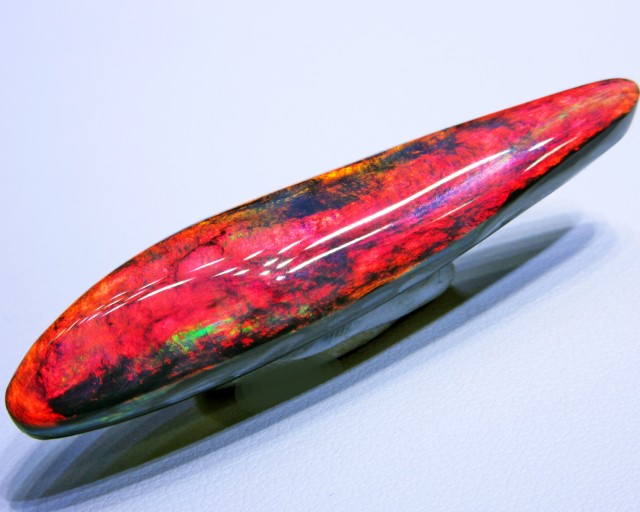
They’re called stones fallen from heaven, living fire, an anchor stone of hope. Some swear they made the owner invisible. We just call them opals and their story is magical.
The finest opals come from Australia. It’s not just a boast, it’s also a fact. Not only the finest, but also the most – 95% of all opals are eked out of this great continent.
Black opals – which aren’t really …..
…..light opals, which are….
……. and boulder opals, which are a bit of both
– come in all shapes and sizes, but most importantly must have the fire that marks the gem.
Even the mining areas sound a little magical – Lightening Ridge, Mintabie, Andamooka, Quilpie and White Cliffs. Perhaps the biggest mining area is at Coober Pedy, in the very heart of the Australian outback.
Coober Pedy is like nowhere else – literally an up-side-down world where the living make their homes and work underground and out of sight, while the cemetery is up-top and in the open!
Flying over the town also gives a bird’s-eye view of the strange formations made from individual mine shafts. It’s claimed there are up to four million shafts in and around the town, giving it more of a Martian landscape.
A millionaire in Coober Pedy (and they claim there are quite a few) looks the same as every other dust-coated, jeans and plaid-wearing worker; some have struck lucky in just a few feet of fine dirt, others have toiled for decades and never found a chip of colour. They say it is addictive. This miner told us he had already made a million by the turn of the 1980’s. In 2016 he was still down in the dirt.
For all their value, opals started life as nothing more than trickles of silica running through cracks in the earth. Thanks to the inimitable creativity of Mother Earth, what gets chipped out the other side, millennia later is, if you are lucky, a milky stone of fire.
The stones have been lauded throughout time. Cleopatra was a big fan as were many royals and dignitaries. Roman women prized them above all other stones and the generals often carried opal-tipped staves into battle for luck. The not-so-lucky Marie Antoinette owned one called the Forest Fire. Opals were responsible for founding of London’s famous Hatton Gardens jewellery quarter after Sir Christopher Hatton presented the virgin Queen Elizabeth with a fine set of gems and in return she booted the bishops out of the Palace at Ely and presented Sir Chris with a fine place to live and work. The palace grounds became Hatton Gardens. A much more recent Elizabeth – Taylor – was also an avid collector, as were Andy Warhol and Elvis Presley.
It was originally thought that the gems were only found in the Carpathian Mountains in Europe, in a location so secret that the miners would employ complex subterfuge to remain undiscovered. Opals were also found in Mexico and Peru, feeding the ancient Mayan and Inca desires. Imagine the surprise and delight of opal lovers and miners when the gem they thought only available in a few limited and secret places were found half a planet away in Australia.
Tulle Woolaston is credited as the first large scale trader. It is fitting that Australian opals were first introduced into Europe by Woolaston at Hatton Gardens – the place where is all began centuries earlier.
The opal rush began in earnest in 1889. Originally Coober Pedy the area was known as Umoona by the Aboriginals who lived there. After the mining boom began they renamed it Kupaku Piti, which translates to ‘white man’s hole’.
To look at the mine-fields now you could be forgiven for thinking not much has changed.
Unlike other mineral extraction, opal mining was and still is mainly a family business. Prospectors peg out a fifty metre square and drop 1.5m exploratory shafts.
Then the lateral tunnelling begins.
In 1972 mining was banned underneath the town itself, because of fears that it would simply fall in on itself. There was no detail of who was digging where, and most weren’t just digging, they were dynamiting too. It was the wild west of unregistered and unregulated mining just below the schools, shops and roads and right next to the dug out underground homes. The story is often told of the miner who blew out the lounge room of a neighbour chasing a promising seam. One look from above and the endless miles of mine shafts shows just how real their concerns were.
Exceptions are made for tunneling to make an underground home. It’s claimed that one Coober Pedy bachelor miner has had to dig out 20 bedrooms under the town, “to accommodate his huge extended family who occasionally visit”
And it seems that all the rules, all the bets and all the courtesy goes straight down the hole if you hit the right seam.
Coober Pedy is a town of secrets. No one trusts anyone and no one tells anyone anything. Miners are followed through the night to see if they have found a promising dig. Fortunes maybe won or lost, but all go on under the cover of the underground.
The promise of riches and beautiful gems has also brought hopeful families from all over the world. There are around 3,500 people living permanently in Coober Pedy, with 45 different nationalities.
Some look for divine inspiration, others have divining aspirations, thought it was hard to be convinced that it really worked.
And if you can’t afford to dig, you can still feed your addiction, with a bit of noodling on the side – the terms of digging through the spoil heaps, or tailings, in search of a missed moment. And yes, there are stories of people finding hugely valuable gems in a pile of dirt, of course there are!
Coober Pedy is a curious place, full of mystery and intrigue, where the hopes of many nations come together. Beyond its boundaries is the vast outback, and it also has stories of magic and mystery to share.
The Moon Plain has featured in numerous apocalyptic movies, including Mad Max. Named for its endless empty scape, it is also an important place in Aboriginal stories and Dreamtime.
The Breakaways are a series of spectacular rock formations rising out of the Plain in distinct and distinctive colours. This is considered an important place of learning for young Aboriginal men.
While the two prominent formations are known as salt and pepper or the castle locally, the Aboriginal story tells of two puppies – one white and one yellow, sitting down near their owner the “man” in the shadow behind them.
You can clearly see why the Breakaways is also the main source of red ochre (tudu), used in Aboriginal dressing up ceremonies, as well as the source of other ochre colours.
The outback surrounding Coober Pedy holds millennia of history. From ancient stories, to gems as old as the land itself. It also is part of more modern record-breaking history.
“A fence”, we hear you say, “it’s a fence”. It’s not just a fence. The Dog Fence is the longest fence in the world. This humble stretch of wood and wire built in the 1880’s is one of the longest structures in the world. Designed to keep dingoes away from sheep stock, it runs a mind-boggling 5,614km from the east to the south of Australia.
Hundreds of men live along the fence, working in shifts and sleeping in small huts complete with satellite TV and shortwave radios to keep the barrier intact.
But if size does matter to you, then Anna Creek is for you. It is the world’s biggest property, spread over six million acres, or 24,000km2. If it were a country it would be 150th on the big list – greater than 89 others.
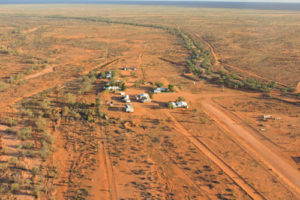
Anna Creek – the largest cattle station in the world, makes the Dog Fence look like a row of toothpicks
Far from being deserted – the Australian outback is full of life and stories. You could say it is both an ancient and modern, priceless gem.